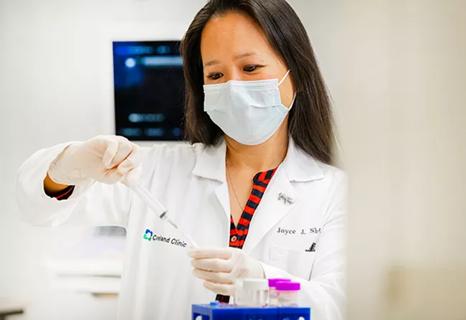A patient’s answer ‘changed everything’

Advertisement
Cleveland Clinic is a non-profit academic medical center. Advertising on our site helps support our mission. We do not endorse non-Cleveland Clinic products or services. Policy
Six years ago, a new patient came into my clinic. He was in his early 30s and on insulin four times a day for poorly controlled type 1 diabetes.
It was a busy day and I was running behind. The fastest fix would be to adjust his insulin and move on, but I quickly asked him when he had been diagnosed.
His answer changed everything — for him, his family and me.
He told me he had been diagnosed as a baby. I asked him when exactly. He responded “shortly after birth,” within his first few hours of life, according to his mom.
That stopped me. It was odd to be diagnosed with type 1 that young, I told him. More likely it was neonatal diabetes, a type of diabetes that can be lifelong but is caused by a genetic disorder and is often easier to treat than type 1.
Did his mother have diabetes too? She did. So did his grandparents. So did his older brother and sister, both diagnosed shortly after birth.
His insurance plan wouldn’t cover genetic testing, but I told him that some cases of neonatal diabetes could be controlled with oral medication, a sulfonylurea. It might be worth a shot. Insulin may not be necessary for him. We talked about trying the medication, but he was very apprehensive and I lost him to follow-up.
A year later, the older brother appeared in my clinic. He had heard about the medication from his brother and was willing to give it a try. I prescribed a combination of two pills, which eventually removed his need for insulin.
Next came the sister, who today is on a combination of three pills and one shot of insulin per day. Her diabetes control has vastly improved and she no longer needs four shots of insulin per day.
Advertisement
The initial patient finally followed his siblings. He’s now on a sulfonylurea — with no insulin at all — and has the best diabetes control of his life.
To live for more than 30 years thinking you have type 1 diabetes and will need blood glucose checks and insulin every day for the rest of your life, to learning you don’t need insulin at all is nothing short of a miracle.
Had I not asked the patient about the history of his disease, I’d never have discovered the alternative diagnosis nor recommended the treatment that eventually transformed his care and the care of his family members.
Taking detailed patient histories was a fundamental we all learned in medical school. Unfortunately, in practice it sometimes gets lost due to time constraints, reliance on past medical history recorded by other providers, and other factors. How often do we order all kinds of diagnostic tests but still never uncover the most important details, which patients, themselves, could simply tell us?
Through this experience, I’ve learned three important things:
Advertisement
The crux of medicine has always been establishing good rapport with patients and taking a thorough history. It’s important to get back to our basics, and not let time-crunched workdays stop us from being good investigators and caregivers.
Dr. Pantalone is a staff endocrinologist and Director of Clinical Research in the Department of Endocrinology at Cleveland Clinic.
Advertisement
Advertisement

Association revises criteria for the diagnosis and resolution of severe conditions

Falling from standing height should not break bones

Comprehensive approach can make a transformative impact

Screening and medication key to better outcomes

While the skeletal effects of nutrient deficiency are well-known, it’s important to consider how deficiency impacts the endocrine system

The tool can provide better clarity on evaluation of indeterminate thyroid nodules, reduce the number of unnecessary surgeries and help providers tailor patient care

Guidance for counseling patients on the use of one of the most common daily supplements taken in the US

Two case studies illustrate why it’s important to look at DXA data holistically when treating patients with fracture risk